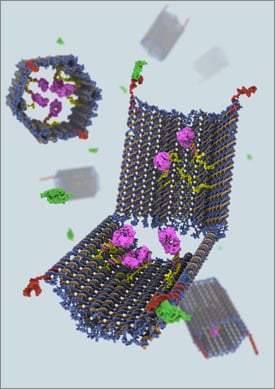 |
| Harvard researchers have crafted a self-assembling, self-destructing drug delivery platform using DNA origami--courtesy of the Wyss Institute |
Since its advent in 2006, DNA origami has stirred the imaginations of scientists around the world. Essentially, if you sequence DNA's four bases the right way, they will bind together naturally, allowing researchers to craft complicated shapes that fold together on their own.
Now, researchers at Harvard's Wyss Institute are using the method to develop self-assembling, self-destructing drug delivery vessels. They created an open DNA tube with a hinge on one side, allowing it to be filled with a drug and then clasped shut.
Holding it shut are DNA aptamers, which can be configured to identify and seek certain proteins, allowing them to be programmed to find diseased tissue. Once the origami nanobots get there, the aptamers recognize the infected cells and break apart, swinging open the tube and releasing the treatment therein. In essence, the scientists have created a lock-and-key system, they said.
"It's autonomous," Shawn Douglass, one of the head researchers, told The Guardian. "We make it and it's ready to go. We mix it with cells and it performs the final stages by itself." In lab tests, the researchers encoded the aptamers to hunt down leukemia and lymphoma cells and saw some success.
The institute's nano platform is in its early stages, and the scientists say they've got a lot more work to do before it can be tested in humans. But it's another advancement in the world of DNA origami, following the work of Oxford scientists who engineered similar molecules that could endure cellular attacks in the kidneys and deliver treatment. Before that, researchers at Arizona State figured out how to mimic naturally occurring shapes using DNA origami.
- here's the institute's release
- get more from The Guardian
- check out a video on the platform